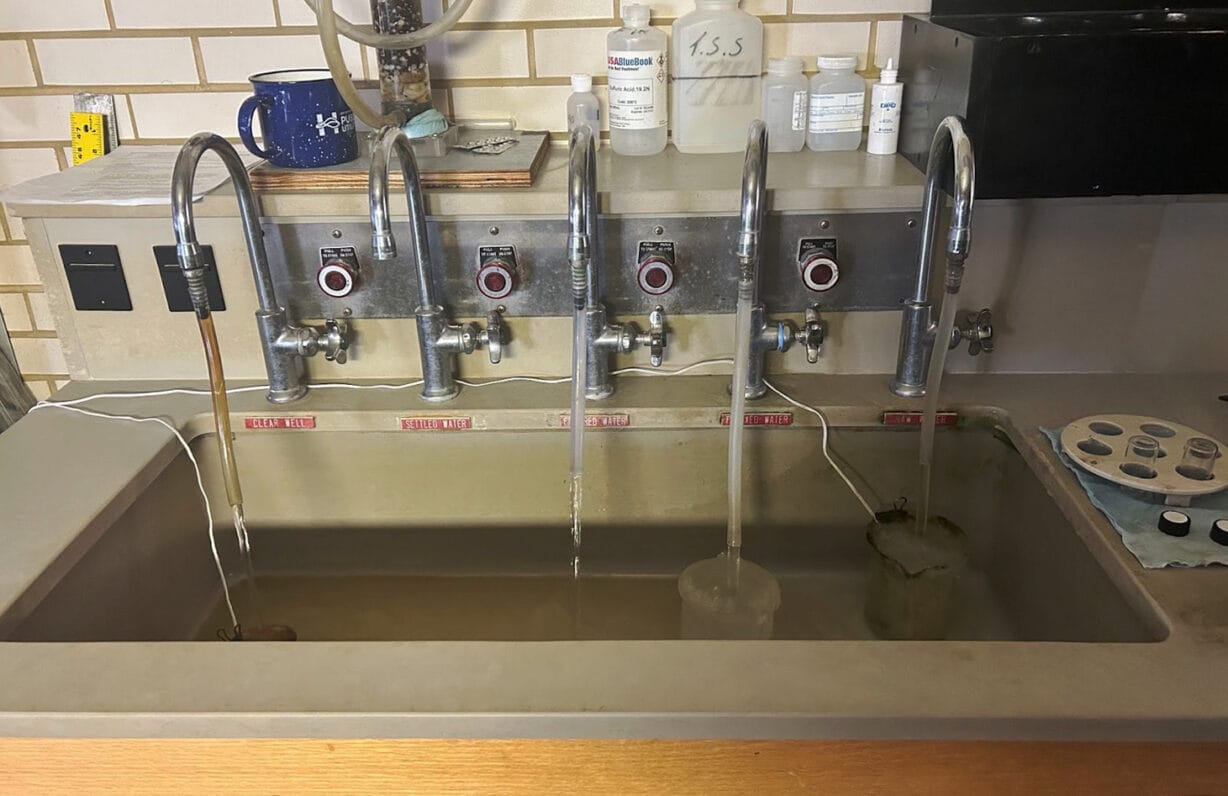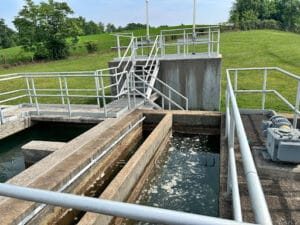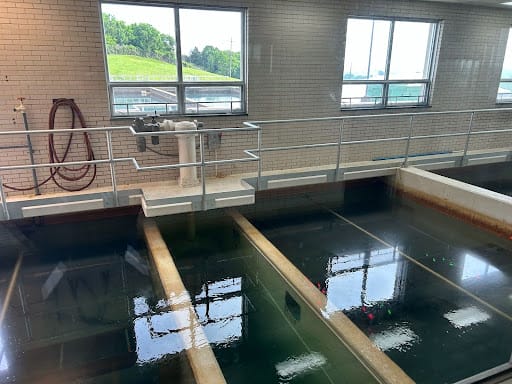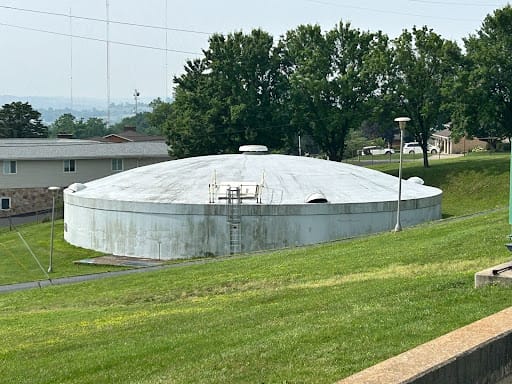
By Jackson Hephner, contributor
As heavy rains battered the Valley last month, the city’s water treatment plant faced a major problem. Water coming into the facility after the May 14 rainstorm wasn’t just cloudy or tinted. It was brown.
The vats of brown liquid — resembling milky coffee rather than clear, drinkable water — prompted the city to issue a conservation order so that people would reduce their use. It meant no watering lawns or gardens, shorter showers and baths and that people needed to avoid letting water run when not absolutely necessary. The conservation order lasted a little over a week.
It wasn’t the first time an issue like this has happened. Incidents like this, though rare, can happen after strong, heavy rains. Harrisonburg Director of Public Utilities Mike Collins told the city council at the May 27 meeting that in his 36 years with the city, he’s seen “10 similar events like this.”
Still, there were a few factors in this most recent instance that caused the brown water to overwhelm the filters.
The plant draws its water from the Dry River in Rawley Springs and the North River in Bridgewater, which are both surface water sources.
Michael Parks, Harrisonburg’s director of communications and public engagement, said while the city can’t know for certain what caused the issue, the most likely explanation is that the drought earlier in the year had lowered the water levels to the point that the heavy rains mixed up silt and dirt from the bottom of the rivers.
“I think it was just kind of a perfect storm of these things in the water,” Parks said.
The challenge for the city’s water treatment process then, is preparing for those storms — perfect and otherwise.
Inside (and outside) the water treatment plant
The water treatment process begins on the outside of the plant. As water arrives, it is stored in large, rectangular basins that sit behind the main building. That water is treated, causing the materials in the water to bond and slowly drop to the bottom of the basin. On a clear day, the unwanted particles at the bottom of the basins can even become visible.

(Photo by Jackson Hephner)
The plant is designed so the water slowly moves toward the inside of the building, giving enough time for unwanted materials to drop out.
Once inside, the water is moved through the bottom of a few smaller basins, equipped with multiple filters that catch any remaining unwanted materials as the water moves toward the bottom of the facility and is pumped out.
“When we’re talking about filters, this is what we’re talking about,” Parks said. “It’s different materials, different density of materials, that as the water sinks through, it’s trapping different materials.”

(Photo by Jackson Hephner)
This process does require the filters to be backwashed regularly, with the plant having a dedicated tank for the waste that is caught by the backwash. This was one of the main problems that prompted the water conservation order. The treatment plant needed to backwash so much because of the increased turbidity — or cloudiness — of the water that the filters clogged and the tank holding the waste almost ran out of room.
From the lab inside the treatment plant, employees monitor the entire process, from when the water is pumped from the river to when it reaches a tank. A wall of monitors connect to cameras that provide a live feed of each step of the process. The lab also has faucets with water samples continuously running through them for regular testing and to ensure it doesn’t sit in the line for too long.
“This is a 24 hour operation here,” Parks said, “so we are always paying attention to that kind of thing, monitoring each pump station, each tank, the filters, and seeing if any action needs to be taken.”
The week-long fix
During the water conservation order, Parks said two to three people were at the facility at all times, including either the director or deputy director of public utilities.
There, they monitored the water coming in from both the North and Dry rivers and tried adding new combinations of chemicals into the water.
“We actually had individuals from the wholesalers of the chemicals come in and say, ‘Look at what we’re seeing here,’” Parks said. “‘You were the expert on this chemical. What are you seeing? What do you think we could do differently?’”
While all of this was happening at the plant, city officials were on the phone with the city’s heavy water users, such as those in the Poultry Industry and their partners at JMU, to see what they could do on their end. Parks said the split in water use between residential and commercial customers is about 50-50.
“What most of our community saw was a more measured approach to messaging, ‘Turn the water off when you’re brushing your teeth. Don’t take baths. Take a quick shower,’” Parks said. “Our heavy water users were hearing a different conversation, one-on-one, like, ‘Listen, you use a million gallons a day. We need you to consider what you could do.’”
These commercial customers responded by using water stored on-site or even eliminating shifts. If the situation had escalated, Parks said the city has the ability to even shut off water to these heavy users, an action he said the city would not take lightly.
However, that action was never needed. At all times, the facility had a least 7 million gallons in storage. Considering the city uses 10-12 million every day, that could have been a major issue if no water was coming out of the facility. But while part of the plant was closed down at one point, the facility was still pumping out water, so the stored water wasn’t needed.

Flowing into the future
With the treatment facility back to normal operations, the city is now looking ahead to how to make improvements.
At his presentation to the city council, Collins outlined several plans to improve the plant in the future.
In the short-term, he wants to upgrade the backwash system as soon as possible as well as investing in more types of coagulants and coagulant aids.
Parks said the city has been working for the past 20 years on adding the south fork of the Shenandoah River as an additional water source, and Collins told the city council that the fork will be brought online in 2026.
Ultimately, the city plans to build a new treatment plant with more capacity in 2044.
“In the long term we’re going to end up with a mix of two more cards to play,” Collins said. “And I think that’s the best thing you can do is give your facilities tools to work with.”
After the conservation order, city officials discussed and began reevaluating these plans, both short and long-term.
City Manager Ande Banks told The Citizen after the June 10 meeting that Collins and his team already have prioritized increasing the capacity of the plant to effectively clean the filters but said that longer-term goals, like the plans already in place to expand the plant in the 2040s, were being re-evaluated as well.
“Everything from long-term plans to immediate term facility upgrades has been on the board for consideration in the aftermath of that,” Banks said.
For now, Collins and his team will continue to monitor the plant, implement improvements to the facilities and continue to reevaluate how they can improve the process of getting water to the city. In the meantime, Banks said what the city’s residents can do is continue to have faith in the city’s water system.
“We have some of the cleanest water in the entire Commonwealth of Virginia,” he said. “We update an annual report on those quality tests. At no time, even during this, did the water quality drop.”
— City council reporter Lizzie Stone contributed to this article with reporting from the May 27 city council meeting.
Thanks for reading The Citizen, which won the Virginia Press Association’s 2022 News Sweepstakes award as the top online news site in Virginia. We’re independent. We’re local. We pay our contributors, and the money you give goes directly to the reporting. No overhead. No printing costs. Just facts, stories and context. We value your support.












